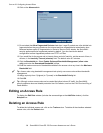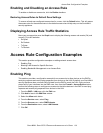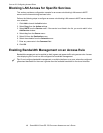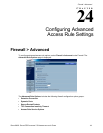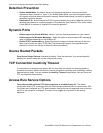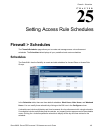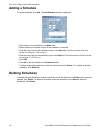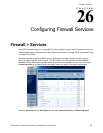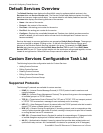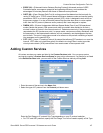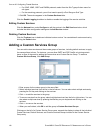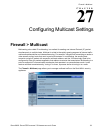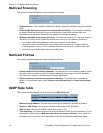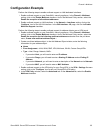146
SONICWALL SONICOS ENHANCED 2.5 ADMINISTRATOR’S GUIDE
C
HAPTER
26:
Configuring Firewall Services
Default Services Overview
The Default Services view displays the SonicWALL security appliance default services in the
Services table and Service Groups table. The Service Groups table displays clusters of multiple
default services as a single service object. You cannot delete or edit these predefined services. The
Services table displays the following attributes of the services:
•Name—the name of the service
•Protocol—the protocol of the service
•Port Start—the starting port number for the service
•Port End—the ending port number for the service
•Configure—Displays the unavailable Notepad and Trashcan icon (default services cannot be
edited or deleted, you will need to add a new service for the Notepad and Trashcan icons to
become available).
Services that apply to common applications are grouped as Default Service Groups. These groups
cannot be changed or deleted. Clicking on the + to the left of the Default Service Groups entry,
displays all the individual Default Services included in the group. For example, the DNS (Name
Service) entry has two services labelled DNS (Name Service) TCP for port 53 and DNS (Name
Service) UDP for port 53. These multiple entries with the same name are grouped together, and are
treated as a single service. Default Services Groups cannot be edited or deleted.
Custom Services Configuration Task List
The following list provides configuration tasks for Custom Services:
• Adding Custom Services
• Editing Custom Services
• Deleting Custom Services
• Editing Custom Services Groups
• Deleting Custom Services Groups
Supported Protocols
The following IP protocols are available for custom services:
ICMP (1)—(Internet Control Message Protocol) A TCP/IP protocol used to send error and
control messages.
IGMP (2)—(Internet Group Management Protocol) The protocol that governs the management
of multicast groups in a TCP/IP network.
TCP (6)—(Transmission Control Protocol) The TCP part of TCP/IP. TCP is a transport protocol
in TCP/IP. TCP ensures that a message is sent accurately and in its entirety.
UDP (17)—(User Datagram Protocol) A protocol within the TCP/IP protocol suite that is used in
place of TCP when a reliable delivery is not required.
GRE (47)—(Generic Routing Encapsulation) A tunneling protocol used to encapsulate a wide
variety of protocol packet types inside IP tunnels, creating a virtual point-to-point link to firewalls
or routing devices over an IP internetwork.
ESP (50)—(Encapsulated Security Payload) A method of encapsulating an IP datagram inside
of another datagram employed as a flexible method of data transportation by IPSec.
AH (51)—(Authentication Header) A security protocol that provides data authentication and
optional anti-relay services. AH is embedded in the data to be protected (a full IP datagram).



